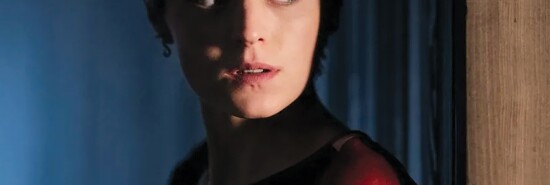
The subtlety of A Murder at the End of the World
Graham Hillard
The work of Brit Marling, the screenwriter and actress behind Netflix’s 2016 puzzle box The OA, can only be described as interestingly flawed. That series, her debut as a showrunner, was a saga of dimension-hopping and imprisonment, co-starring Phyllis from The Office and featuring a school shooting thwarted by synchronized dance. And that’s barely scratching the surface of its weirdness. That Marling was the creative force behind the cult-hit films Sound of My Voice and Another Earth (both 2011) merely adds to her intrigue. Like all artists with a slightly too specific vision, Marling produces content that repels and entices in equal measure. Yet it’s hard not to think she could create something thrilling if she aimed only a little more broadly.
That possibility may well have come to fruition with A Murder at the End of the World, Marling’s fifth collaboration with co-creator Zal Batmanglij and a sure contender for best limited series of the year. Now streaming on Hulu at the deliciously old-fashioned rate of one episode per week, the new show is True Detective meets And Then There Were None, with a dash of techno-pessimism thrown in for good measure. Or is that techno-optimism? Like the best dramas of ideas, A Murder at the End of the World hesitates to referee its characters’ debates, preferring to let convictions spin into the ether and collide. I know, but will try not to say, whom I loved and hated while absorbing the show’s seven intricately constructed episodes. The viewer is sure to have his or her own opinions.
CUSTOMERS SURPRISED TO DISCOVER THEIR RENTAL IS AN ELECTRIC VEHICLE
The series stars Emma Corrin as Darby Hart, a 20-something hacker-cum-detective referred to by one character as a “Gen-Z Sherlock Holmes.” The recent author of a true-crime memoir, Darby is busy hawking her book when an unusual invitation arrives from one Andy Ronson (Clive Owen), a tech titan with pretensions to messianic grandeur. Should our heroine accept, she will be whisked to a weeklong retreat in which nine inventors and artists are gathering to “discuss technology’s role in ensuring a human future.” The location: a luxury hotel in remotest Iceland, hours from Reykjavik and civilization. The itinerary: murder. Or so it appears when, one by one, the guests begin to drop dead.
By my count, Hulu’s new show is the third homage to Agatha Christie’s best-loved novel to hit screens in as many years. The first, HBO’s The Head (2021), used polar isolation to similar effect, locking its characters in a claustrophobic research station from which escape was impossible. The second, Rian Johnson’s execrable Glass Onion (2022), traded frozen climes for an idyllic Greek isle but featured, like Marling’s limited series, a cast of jet-setting elites. It is no mystery why the Davos crowd makes for good victims in productions like these: Even Democrats hate such people. To its credit, however, Marling’s work buries any disdain it may have beneath layers of careful plotting. When a character asserts that “the future of everything is in collaboration with artificial intelligence,” he isn’t only marking himself as a slave to hype. He’s assigning himself a motive.
As for Darby’s suspicions, they are, in the best murder-mystery tradition, both shifting and uncertain. Might the killer be Rohan (Javed Khan), whose midnight encounter with the first victim was structured to avoid hotel security? Or David (Raul Esparza), whose gauche distinctions between “builders” and “nonbuilders” could well mask darker views? Through at least 4 1/2 episodes, I had an eye on Lee (Marling herself), Ronson’s wife and reputedly “the greatest female coder to have ever lived.” For that matter, why not point a finger at Ronson’s miraculous AI assistant, Ray (Edoardo Ballerini)? So advanced is that specter’s functionality that it could surely off a few tech bros on vacation. At least in my house, audiences would cheer.
Yet A Murder at the End of the World is not, it bears repeating, a Luddite jeremiad in Christie-an garb. Rather, the series employs technological innovation in the same way the Queen of Mystery used, say, inheritances: as a dramatic ingredient that makes murder worthwhile. Among the most vibrant of the show’s characters is Bill Farrah (Harris Dickinson), a provocative artist whose “Artificial Insanity” project takes tech-utopianism to task. Bill’s cynicism, however, is merely one perspective of many. Smiles cross several faces when Ronson unveils an advancement in “swarm robotics,” in which drones collaborate outside of human control. A lesser show might have greeted such a development with unadulterated panic or glee. We can’t be sure which side Marling’s series is on.
CLICK HERE TO READ MORE FROM THE WASHINGTON EXAMINER
There is, finally, the matter of competing timelines, a narrative device made commonplace by contemporary television but used here to excellent effect. Six years before reuniting in Iceland, Darby and Bill were partners, then lovers, on the hunt for a serial killer of women. One can’t help thinking, watching the show unfold, that Marling and company will find a way to consolidate the two narratives. Even if not, however, the show’s many flashbacks are welcome, featuring as they do two actors of rare subtlety and control. Indeed, the show’s performances are strong throughout. Has anyone ever wanted less Clive Owen? Throw in a compelling score, dazzling cinematography, and Batmanglij’s knack for framing a scene, and one has a series that earns its run time and then some. Coming to the show’s last scenes, I was sorry to have to stop watching.
I will not spoil the finale, of course, except to say that it ties loose threads together in a way that is surprisingly life-affirming given the series’s themes. Is justice done? Not quite. But that is just a part of being human.
Graham Hillard is a Washington Examiner magazine contributing writer and editor at the James G. Martin Center for Academic Renewal.
